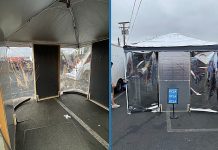
Researchers have made a remarkable stride towards creating a special material that could revolutionize tissue growth in labs.
This breakthrough could pave the way for healing injuries and testing new drugs without using animals.
At Rice University, Professor Jeffrey Hartgerink and his team have been on a mission for over a decade.
They aim to mimic the structure of muscle and nerve tissues using tiny nanofibers. These fibers are like microscopic threads that can guide the growth of cells in a specific direction, just like how ropes can guide a climber.
In their latest study, published in ACS Nano, they unveiled a new method to make these nanofibers align perfectly.
It’s like arranging noodles side by side in a bowl, but these “noodles” are so tiny, they’re smaller than a cell.
By carefully controlling the process, they discovered that they could make the nanofibers line up even better by adjusting the amount of salt in the solution.
Lead author Adam Farsheed, who recently earned his PhD, explains that this alignment is crucial for guiding cells to grow in the right way. Imagine trying to build a bridge without a blueprint—it’s the same idea.
These aligned nanofibers act like guides, telling the cells where to go and how to organize themselves.
But here’s the surprising part: too much alignment can actually backfire. When the nanofibers are too stiff and perfectly aligned, the cells don’t respond well.
It’s like trying to follow a strict rulebook that doesn’t leave any room for flexibility. The researchers found that cells need a bit of freedom to “pull” on the nanofibers, allowing them to recognize the alignment and arrange themselves accordingly.
This discovery could have big implications for tissue engineering and designing new materials for medical use. Understanding how cells interact with these tiny structures could help scientists create better strategies for building tissues that function properly.
With support from organizations like the National Institutes of Health and the National Science Foundation, this research opens up exciting possibilities for the future of regenerative medicine.
Imagine a world where injuries can be healed with lab-grown tissues, and new drugs can be tested without harming animals. Thanks to these aligned “noodles,” that future might not be too far away.



